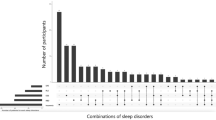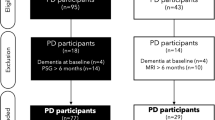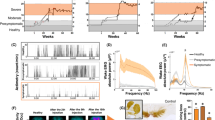Abstract
To investigate the effect of the dopamine D2 and D1 receptor agonist cabergoline on sleep, periodic leg movements (PLMs) in sleep, and early morning motor performance in patients with Parkinson's disease (PD). It was hypothesized that cabergoline had long-lasting beneficial effects on sleep and PLMs in sleep in patients with PD, after a single evening intake. A total of 15 patients with idiopathic PD underwent two nights of polysomnography and motor tests (UPDRS, tapping test) before and after 6–8 weeks of treatment with cabergoline (dosage: 3–6 mg/day). Additionally, patients completed a subjective sleep visual analog scale (VAS) before and during cabergoline treatment. Compared to baseline values, treatment with cabergoline did not change sleep efficiency or the amount of stage 1 and stage 2 sleep. The number of awakenings (22.4±10.1 vs 32.5±13.3, p<0.05) and stage shifts (119±42 vs 148±46, p<0.05) were increased during treatment with cabergoline, and PLMs in sleep were reduced (PLM index 34.9±44.9 vs 6.7±4.2 per hour, p<0.05). Cabergoline significantly improved early morning motor function, and in spite of increased phase shifts and awakenings, patients felt significantly more refreshed in the morning during cabergoline therapy. Cabergoline slightly fragmented sleep, without altering its total amount. The functional significance of this finding is uncertain. The subjective quality of sleep improved, and periodic limb movements in sleep decreased.
Similar content being viewed by others
Log in or create a free account to read this content
Gain free access to this article, as well as selected content from this journal and more on nature.com
or
References
Ahlskog JE, Muenter MD, Maraganore DM, Matsumoto JY, Lieberman A, Wright KF et al (1994). Fluctuating Parkinson's disease. Treatment with the long-acting dopamine agonist cabergoline. Arch Neurol 51: 1236–1241.
Askenasy JJ (1993). Sleep in Parkinson's disease. Acta Neurol Scand 87: 167–170.
Askenasy JJ, Yahr MD (1984). Suppression of REM rebound by pergolide. J Neural Transm 59: 151–159.
Atlas Task Force of the American Sleep Disorders Association Guilleminault C (1993). Recording and scoring leg movements. Sleep 16: 748–759.
Atlas Task Force of the American Sleep Disorders Association (1992). EEG arousals: scoring rules and examples. Sleep 15: 173–184.
Blagrove M, Owens DS, MacDonald I, Sytnik N, Tucker P, Folkard S (1998). Time of day effects in, and the relationship between, sleep quality and movement. J Sleep Res 7: 233–239.
Bliwise DL, Willians ML, Irbe D, Ansari FP, Rye DB (2000). Inter-rater reliability for identification of REM sleep in Parkinson's disease. Sleep 23: 671–676.
Brunner H, Wetter TC, Hogl B, Yassouridis A, Trenkwalder C, Friess E (2002). Microstructure of the non-rapid eye movement sleep electroencephalogram in patients with newly diagnosed Parkinson's disease: effects of dopaminergic treatment. Movement Disord 17: 928–933.
Cianchetti C, Masala C, Mangoni A, Gessa GL (1980). Suppression of REM and delta sleep by apomorphine in man: a dopamine mimetic effect. Psychopharmacology 67: 61–65.
Chouza C, Aljanati R, Caamano JL, De Medina O, Scaramelli A, Buzo R et al (1990). Long-term treatment with Madopar HBS in parkinsonians with fluctuations. Adv Neurol 53: 519–526.
Fahn S, Elton RL, Members of the UPDRS development committee (1987). Unified Parkinson's disease rating scale. In: Fahn S, Marsden CD, Calne DB, Goldstein M (eds) Recent Development in Parkinson's Disease, Vol. 2 MacMillan Healthcare Information: Florham Park, NJ. pp 153–163; 293–304.
Fariello RG (1998). Pharmacodynamic and pharmacokinetic features of cabergoline. Rationale for use in Parkinson's disease. Drugs (Suppl 1): 10–16.
Freeman A, Ciliax B, Bakay R, Daley J, Miller RD, Keating G et al (2001). Nigrostriatal collaterals to thalamus degenerate in parkinsonian animal models. Ann Neurol 50: 321–329.
Laihinen A, Alihanka J, Raitasuo S, Rinne UK (1987). Sleep movements and associated autonomic nervous activities in patients with Parkinson's disease. Acta Neurol Scand 76: 64–68.
Lapierre O, Montplaisir J (1992). Polysomnographic features of REM sleep behavior disorder: development of a scoring method. Neurology 42: 1371–1374.
Lees AJ, Blackburn NA, Campbell VL (1988). The nighttime problems of Parkinson's disease. Clin Neuropharmacol 11: 512–519.
Lera G, Vaamonde J, Rodriguez M, Obeso JA (1993). Cabergoline in Parkinson's disease: long-term follow-up. Neurology 43: 2587–2590.
Mahowald M, Schenck CH (1995). REM sleep behavior disorder. In: Kryger M, Roth T, Dement W (eds) Principles and Practice of Sleep Medicine, 2nd edn WB Saunders: Philadelphia. pp 574–588.
Montplaisir J, Michaud M, Denesle R, Gosselin A (2000). Periodic leg movements are not more prevalent in insomnia or hypersomnia but are specifically associated with sleep disorders involving a dopaminergic impairment. Sleep Med 1: 163–167.
Montplaisir J, Nicolas A, Denesle R, Gomez-Mancilla B (1999). Restless legs syndrome improved by pramipexole: a double-blind randomized trial. Neurology 52: 938–943.
Pahwa R, Busenbark K, Huber SJ, Michalek D, Hubble JP, Koller WC (1993). Clinical experience with controlled-release carbidopa/levodopa in Parkinson's disease. Neurology 43: 677–681.
Poewe W, Högl B (2000). Parkinson's disease and sleep. Curr Opin Neurol 13: 423–426.
Provini F, Vetrugno R, Meletti S, Plazzi G, Solieri L, Lugaresi E et al (2001). Motor pattern of periodic limb movements during sleep. Neurology 57: 300–304.
Rechtschaffen A, Kales A (eds) (1968). A Manual of Standardized Terminology, Techniques and Scoring System for Sleep Stages of Human Subjects. Brain Information Service/Brain Research Institute, University of California: Los Angeles.
Rye DB, Jankovic J (2002). Emerging views of dopamine in modulation sleep/wake state from an unlikely source: PD. Neurology 58: 341–346.
Stiasny K, Robbecke J, Schuler P, Oertel WH (2000). Treatment of idiopathic restless legs syndrome (RLS) with the D2-agonist cabergoline—an open clinical trial. Sleep 23: 349–354.
Tandberg E, Larsen JP, Karlsen K (1998). A community-based study of sleep disorders in patients with Parkinson's disease. Movement Disord 13: 895–899.
Trenkwalder C (1998). Sleep dysfunction in Parkinson's disease. Clin Neurosci 5: 107–114.
Wauquier A (1995). Pharmacology of the catecholaminergic system. In: Kales AD (ed) The Pharmacology of Sleep. Handbook of Experimental Pharmacology, Vol. 116 Springer: Berlin, Heidelberg: New York. pp 65–85.
Wetter TC, Collado-Seidel V, Pollmächer T, Yassouridis A, Trenkwalder C (2000). Sleep and periodic leg movement patterns in drug-free patients with Parkinson's disease and multiple system atrophy. Sleep 23: 361–367.
Wetter TC, Stiasny K, Winkelmann J, Buhlinger A, Brandenburg U, Penzel T et al (1999). A randomized controlled study of pergolide in patients with restless legs syndrome. Neurology 52: 944–950.
Acknowledgements
We are grateful to F Gander PhD, Max Planck Institute of Psychiatry, Munich, for performing the statistical tests. Pharmacia supported the study and the polysomnographic recordings by a research grant.
Author information
Authors and Affiliations
Corresponding author
Rights and permissions
About this article
Cite this article
Högl, B., Rothdach, A., Wetter, T. et al. The Effect of Cabergoline on Sleep, Periodic Leg Movements in Sleep, and Early Morning Motor Function in Patients with Parkinson's Disease. Neuropsychopharmacol 28, 1866–1870 (2003). https://doi.org/10.1038/sj.npp.1300250
Received:
Revised:
Accepted:
Published:
Issue date:
DOI: https://doi.org/10.1038/sj.npp.1300250
Keywords
This article is cited by
-
Early morning off in patients with Parkinson’s disease: a Chinese nationwide study and a 7-question screening scale
Translational Neurodegeneration (2020)
-
Schlafstörungen beim idiopathischen Parkinson-Syndrom
InFo Neurologie & Psychiatrie (2017)
-
The relevance of dopaminergic level in nocturnal disability in Parkinson’s disease: implications of continuous dopaminergic stimulation at night to treat the symptoms
Journal of Neural Transmission (2014)
-
When Parkinson’s disease patients go to sleep: specific sleep disturbances related to Parkinson’s disease
Journal of Neurology (2011)
-
Rotigotine transdermal system for control of early morning motor impairment and sleep disturbances in patients with Parkinson’s disease
Journal of Neural Transmission (2010)



